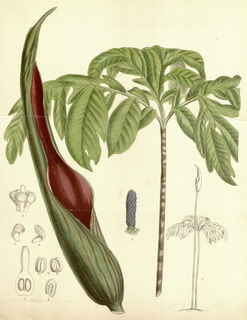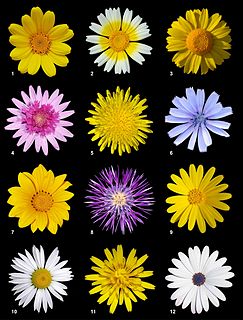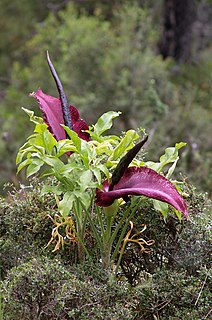
Tarragon, also known as estragon, is a species of perennial herb in the sunflower family. It is widespread in the wild across much of Eurasia and North America, and is cultivated for culinary and medicinal purposes.

Amorphophallus is a large genus of some 200 tropical and subtropical tuberous herbaceous plants from the Arum family (Araceae), native to Asia, Africa, Australia and various oceanic islands. A few species are edible as "famine foods" after careful preparation to remove irritating chemicals.

Bistorta officinalis, known as bistort, common bistort, European bistort or meadow bistort, is a species of flowering plant in the dock family Polygonaceae native to Europe and north and west Asia. Other common names include snakeroot, snake-root, snakeweed and Easter-ledges.

Bistorta vivipara is a perennial herbaceous flowering plant in the knotweed and buckwheat family Polygonaceae, commonly known as alpine bistort. Scientific synonyms include Bistorta vivipara and Polygonum viviparum. It is common all over the high Arctic through Europe, North America, and temperate and tropical Asia. Its range stretches further south in high mountainous areas such as the Alps, Carpathians, Pyrenees, Caucasus, and the Tibetan Plateau.
Voodoo lily is a common name for several plants and may refer to:

Carrion flowers, also known as corpse flowers or stinking flowers, are flowers that emit an odor that smells like rotting flesh. Carrion flowers attract mostly scavenging flies and beetles as pollinators. Some species may trap the insects temporarily to ensure the gathering and transfer of pollen.

Arum is a genus of flowering plants in the family Araceae, native to Europe, northern Africa, and western and central Asia, with the highest species diversity in the Mediterranean region. Frequently called arum lilies, they are not closely related to the true lilies Lilium. Plants in closely related Zantedeschia are also called "arum lilies".

Dracontium is a genus of flowering plants similar to those of Amorphophallus. Unlike Amorphophallus which is found in the Old World, this genus has a New World distribution and is native to South America, Central America, southern Mexico, and the West Indies.
Green Dragon may refer to:

Arisaema dracontium, the dragon-root or green dragon, is a herbaceous perennial plant in the genus Arisaema and the family Araceae. It is native to North America from Quebec through Minnesota south through Florida and Texas, where it is found growing in damp woods. It has also been reported from northeastern Mexico Plants grow 20–50 centimetres (7.9–19.7 in) tall when in bloom and after flowering reach 100 centimetres (39 in), and each grows from a corm. Normally, a plant produces one leaf with a long petioles, its leaf is composed of 7 to 13 leaflets, with its central leaflet being the largest one and with leaflets becoming smaller as they are produced distally, the leaflets are held out horizontally over the plant. During flowering in spring, a single slender, green spathe 3–6 centimetres (1.2–2.4 in) long is produced; it covers a tapering, long thin spadix. The tail-like spadix grows out around the top of its spathe. After flowering, up to 150 berries are produced in a club-shaped column. In late summer, the green berries turn orange-red, each berry produces 1 to 3 seeds. It is listed as a vulnerable species in Canada.

Anchomanes is a genus of flowering plants in the family Araceae. The genus is native to tropical Africa.

Aroideae is a subfamily of flowering plants in the Araceae family. It is the largest subfamily in Araceae and consists of about 72 different genera, and 2,300 species. Many Aroideae have spiny pollen grains without a sporopollenin outer exine layer and lacking an aperture.

Dracontioides is a genus of flowering plants in the family Araceae. It was long thought to contain only a single species until a second species was described in 2005. Both are endemic to Brazil.
Lasioideae is a subfamily of flowering plants in the Araceae family. It contain 10 genera: Anaphyllopsis, Anaphyllum, Cyrtosperma, Dracontioides, Dracontium, Lasia, Lasimorpha, Podolasia, Pycnospatha, and Urospatha.

Pseudodracontium is a genus of flowering plants in the Araceae family. It currently consists of 7 species. The genus was created by N. E. Brown in 1882 to account for two species in Amorphophallus and Dracontium. However, molecular evidence may result in Pseudodracontium being sunk into Amorphophallus.

Bistorta is a genus of flowering plants in the Polygonaceae family. As of February 2019 about 40 species are accepted. It has been supported as a separate clade by molecular phylogenetic analysis. Bistorta species are native throughout much of the Northern Hemisphere, as far south as Mexico in North America and Thailand in Asia.

Bistorta bistortoides is a perennial herb in the buckwheat and knotweed family Polygonaceae. The species name remains unresolved.
















